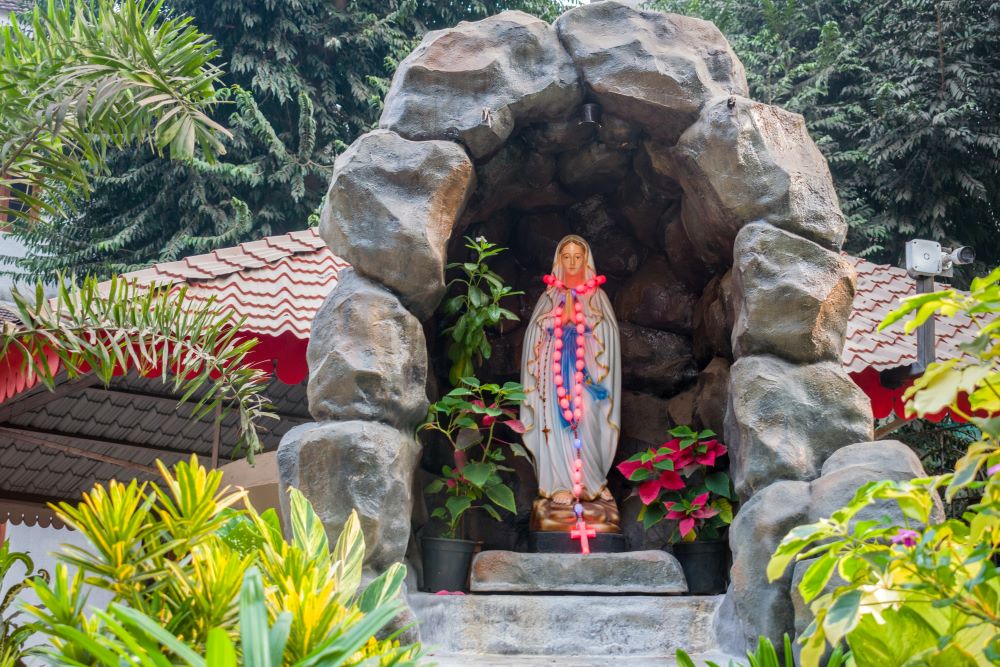
(Unsplash/Sonika Agarwal)
It is a common practice in Asia to remove your footwear before entering sacred places. It is our way of expressing our love and respect toward the Divine, who makes transformation possible. The sacred place is not only believed to be a dwelling place of the Divine, but also a place of deep connectedness with a power higher than ourselves, a space wherein personal and communitarian transformation is possible, a space that helps us reclaim ourselves. This place need not be found only in a distant exotic place or in an intentionally designed place close by; such a place can be discovered in our innermost being, too.
This was true in the life of a woman recently released from prison after having served part of a life sentence. One would expect her to be sorrowful, bitter and fatigued because of the long, lonely and laborious 14 years' imprisonment. But not her. My first encounter with her was just the opposite. She was totally in love with life and invigorated with life-giving energy, bubbling with joy and filled with kindness. Sorrow or pain — none was in her.
She recalled her initial days in prison. She longed to forget her past through some devotion, but where would she get any crystals, or feathers, or sacred threads, or rosaries, or pictures of great gurus? Prison rules barred all of them. She had nothing but empty walls and the bare floor. It was this vacuum and emptiness that brought her face to face with her sorrow, day after day, when she retired to her cell after work.
She wept and wept to vent her pain, grief, anger and shame. It wasn't easy, but there was no other way out except to face these emotions and slowly claim this part of her life. She realized that it wasn't necessary to fight within herself all the time, and she began facing the truth about her life. She was still good, and she discovered this not in a temple or a natural setting, but in the dim and dark corner of the prison. In prison there was no soothing sound of a waterfall, no relaxing music for meditation, no recorded chants to gods and goddesses, nor a therapist to lean on. The prison became her healing sanctuary where she initiated the process of restoring and reclaiming her sacred space.
Advertisement
No place or time can hold it back from us if we desire and heed our inner call of reclaiming our sacred space. Little by little, day by day, our spirits can recover from anything, if only we become attuned to our own internal frequencies and to our innermost divine spaces. Why do we need to deny ourselves our legitimate joyful self? Reclaiming our true authentic self means that we set ourselves free from the habit of fragmentation — of viewing our lives in disintegrated and compartmentalized selves, of seeing ourselves as separate from the wider humanity, of treating ourselves as completely devoid of any impact of the needs of others, of drawing a boundary between the sacred and the secular.
This was evident in the life of Vimala Thakar, a renowned yogi teacher. Along with the disciples of Mahatma Gandhi, she worked for the uplift of rural India until she met a spiritual teacher, Jiddu Krishnamurthi. She then became a teacher of meditation and led many retreats and meditations. But a few years later, she was once again back in the villages reaching out to the poor.
In A Path with Heart: A Guide through the Perils and Promises of Spiritual Life, Jack Kornfield described an encounter with Vimala, in which he asked her about this transition. She said:
I am a lover of life, and as a lover of life I cannot keep out from any field of life. So when I stop by a poor village in India and people are sick because of lack of clean water, how can I not stop and respond to this suffering? When I come to London, San Diego or Chicago, I also encounter suffering — not from lack of clean water but from lack of spiritual nourishment. As a lover of life, how can I separate any part from the whole?
This deep interrelatedness emerged from her holistic understanding of life. This is a mark of someone who has reclaimed her own sacred space.
It is this infinite sacred space deep within that moves us to expand beyond ourselves and respond to the needs of those suffering. It also draws us to retreat when we overburden ourselves or lose track of direction in our lives, or become narrow-minded and fragmented. This sacred space needs to be preserved at all time, lest we get carried away either by the wind of change outside or by the storms within. This life, then, becomes meaningful when we constantly reclaim our sacred space, though each one's understanding of the sacred keeps changing and evolving as we grow. How sacred would the world become if only each of us could strive a little more to stay in touch with our inner sacred space and reclaim it both deep within and outside!







